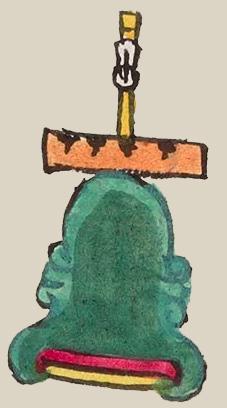Mamalhuaztepec (Mdz7v)
This compound glyph for the place name Mamalhuaztepec has two main components, a hand tool for drilling fire (mamalhuaztli) and a hill or mountain (tepetl). This hill or mountain is a standard, two-tone green with a bell shape, yellow and red horizontal stripes near the base, and curly, rocky outcroppings on the two slopes. The log is a terracotta color (often used for wooden things), and the drill stands perpendicular to the log. The drill has the look of an arrow or dart, decorated with white feathers, and the staff itself the color of a reed (acatl), which was apparently the substance used for making arrows and darts. The log shows four locations for drilling, where black marks appear on the wood. The locative suffix (-c) (as given in the gloss) is not shown visually, but it combines with -tepe- to form -tepec, a visual locative suffix meaning "on the hill" or "on the mountain."
Stephanie Wood
The fire drill was part of a sacred ceremony acknowledging the passing of the fifty-two year calendrical cycle. The word mamalhuaztli had other meanings, including a carrying frame used on a person's back, a pectoral, and a certain constellation that looked like sticks or wands, possibly the Belt of Orion or the Keys of St. Peter (in European terms). Tlachia shows various additional glyphs showing the mamalhuaztli, and these have clear indications of how a pole was held vertically and was spun with the hands with the intention of creating friction at the base. Smoke rises from that site as the fire is started. In U.S. culture, this is a practice taught to Boy Scouts. Fire-making instruments are mentioned still in the late seventeenth century in, for example, Juan Buenaventura Zapata y Mendoza's Historia cronológica de la Noble Ciudad de Tlaxcala, as shown in our Online Nahuatl Dictionary. One wonders whether the use of an arrow decorated with eagle feathers (implying a possible warrior association) also implied a war dimension to the calendrical ceremony.
Stephanie Wood
mamalhuaztepec / puo
Mamalhuaztepec, pueblo
Stephanie Wood
c. 1541, or by 1553 at the latest
Stephanie Wood
drills, drilling, fires, ceremonies, reeds, tules, carrizos, plants, arrows, darts, fire, wood, logs, drills, fuego, madera, troncos, taladros, ceremonias, xiuhpohualli, año, turquesa, xihuitl, feathers, plumas, nombres de lugares

mamalhuaz(tli), a tool or setup for drilling on wood to make fire, https://nahuatl.wired-humanities.org/content/mamalhuaztli
mamali, to drill, https://nahuatl.wired-humanities.org/content/mamali
ma(itl), hand, https://nahuatl.wired-humanities.org/content/maitl
-tepec, on the hill or mountain, https://nahuatl.wired-humanities.org/content/tepec
"On the Hill of the Fire Drill" (apparently agreeing with Berdan and Anawalt) [Frances Karttunen, unpublished manuscript, used here with her permission.]
"On the Hill of the Fire Drill" (Berdan and Anawalt, vol. 1, p. )
Codex Mendoza, folio 7 verso, https://digital.bodleian.ox.ac.uk/objects/2fea788e-2aa2-4f08-b6d9-648c00..., image 25, of 188.
The Bodleian Libraries, University of Oxford, hold the original manuscript, the MS. Arch. Selden. A. 1. This image is published here under the UK Creative Commons, “Attribution-NonCommercial-ShareAlike 3.0 License” (CC-BY-NC-SA 3.0).



